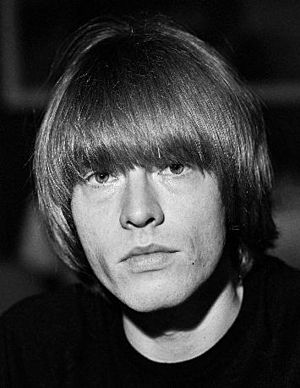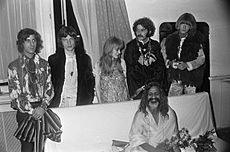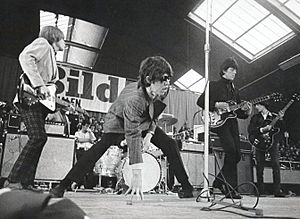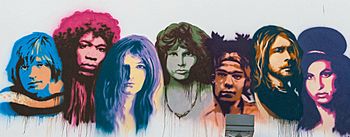Brian Jones facts for kids
Quick facts for kids
Brian Jones
|
|
|---|---|

Jones in 1965
|
|
| Background information | |
| Birth name | Lewis Brian Hopkin Jones |
| Also known as | Elmo Lewis |
| Born | 28 February 1942 Cheltenham, Gloucestershire, England |
| Died | 3 July 1969 (aged 27) Hartfield, East Sussex, England |
| Genres | |
| Occupation(s) |
|
| Instruments | |
| Years active | 1957–1969 |
| Labels |
|
Lewis Brian Hopkin Jones (born 28 February 1942 – died 3 July 1969) was an English musician. He was a multi-instrumentalist and singer. Brian Jones is best known as the person who started the Rolling Stones. He was also their first leader and played guitar.
Brian founded the Rolling Stones in 1962. He also gave the band its famous name. Over time, other band members, Keith Richards and Mick Jagger, started guiding the band's music. This happened especially after they became a successful songwriting team.
Jones and Keith Richards created a special guitar style. Richards called it the "ancient art of weaving." Both guitarists played rhythm and lead parts together. This became a unique sound for the Rolling Stones. However, Brian did not get along with the band's manager, Andrew Loog Oldham. Oldham wanted the band to play different music than Jones's blues style.
In June 1969, the Rolling Stones asked Jones to leave the band. Guitarist Mick Taylor took his place. Less than a month later, Jones died. He drowned in the swimming pool at his home in Cotchford Farm, East Sussex. Many other pop bands mentioned his death in their songs. Famous musicians like Pete Townshend and Jim Morrison wrote poems about him. In 1989, Brian Jones became part of the Rock and Roll Hall of Fame as a member of the Rolling Stones.
Contents
Biography
Early Life and Music
Brian Lewis Hopkin Jones was born in Cheltenham, England, on 28 February 1942. When he was four, he had croup, which led to asthma for the rest of his life. His parents, Lewis and Louisa Jones, were from Wales. Brian had two sisters, Pamela and Barbara. Pamela sadly died young from leukaemia.
Brian went to local schools. He enjoyed badminton and diving. He also played first clarinet in the school orchestra. Brian was good at exams, even though he didn't always try hard. He found school rules difficult and didn't like school uniforms. He was suspended from school twice because he didn't like authority.
Both of Brian's parents loved music. His father taught piano, and his mother played piano and organ. She also led the church choir. Brian listened to classical music as a child. But he really loved blues music, especially artists like Elmore James.
In 1957, he became interested in jazz. Brian convinced his parents to buy him a saxophone. Two years later, for his 17th birthday, they gave him his first acoustic guitar. Brian started playing at local blues and jazz clubs. He also played music on the streets for money, which is called busking.
Forming The Rolling Stones
Brian left his hometown and moved to London. There, he met other musicians like Alexis Korner and Jack Bruce. He became a blues musician and played slide guitar. For a short time, he even called himself "Elmo Lewis."
In May 1962, Brian put an ad in a music newspaper. He was looking for musicians to join a new R&B group. Ian Stewart, a pianist, was the first to join. Later, singer Mick Jagger also joined. Mick and his childhood friend Keith Richards had met Brian at a jazz club. Keith joined the band too.
Brian came up with the name "Rollin' Stones." He got the idea from a Muddy Waters album that had a song called "Rollin' Stone Blues." The Rollin' Stones played their first show on 12 July 1962. It was at the Marquee Club in London.
For a while, Brian, Mick, and Keith shared a flat in Chelsea. They spent their days playing guitar and listening to blues records. Brian also taught Mick how to play the harmonica. The band then found Bill Wyman to play bass and Charlie Watts to play drums. Charlie Watts was known as one of the best drummers in London.
Charlie Watts said that Brian was very important in getting the band started. Brian was determined to get them on stage and paid as an R&B band. In the early days, Brian managed the band's business. He received a little more money than the others. This caused some tension in the group.
Musical Contributions
Brian Jones was a very talented musician. He could play many different instruments. Before he left the Stones in 1969, he often played instruments beyond the usual drums, guitars, piano, and bass. His skills are clear on albums like Aftermath (1966) and Between the Buttons (1967).
As a guitarist, he often used a white teardrop-shaped electric guitar for live shows. He also played guitars from companies like Rickenbacker and Gibson. He was especially good at slide guitar.
You can hear Brian's slide guitar on songs like "I Wanna Be Your Man" (1963) and "Little Red Rooster" (1964). He played sitar on "Paint It Black" and "Street Fighting Man." He played organ on "Let's Spend the Night Together." Brian played marimba on "Under My Thumb" and recorder on "Ruby Tuesday." He also played saxophone on "Child of the Moon" and kazoo on "Cool, Calm & Collected." You can hear his Appalachian dulcimer on "Lady Jane" and Mellotron on "She's a Rainbow."
Brian also played harmonica on many early Rolling Stones songs. These include "Come On" and "Not Fade Away" (1964). He also sang backing vocals on songs like "I Wanna Be Your Man" and "It's All Over Now." He even whistled on "Walking the Dog."
Keith Richards said that their "guitar weaving" style came from listening to blues records. They learned how two guitars could sound like four or five. Brian and Keith's guitar playing became a key part of the Rolling Stones' sound. They both played rhythm and lead parts, often blending them together.
Leaving the Band

When Andrew Loog Oldham became the manager, Brian's role in the band started to change. Oldham wanted the band to write their own songs, like Lennon–McCartney. He also wanted Mick Jagger to be the main focus of their live shows. Brian preferred playing blues cover songs, but the band started playing more original songs written by Jagger and Richards. This made Brian feel less in control.
In 1967, Brian's girlfriend, Anita Pallenberg, left him for Keith Richards. This made the relationship between Brian and Keith even more difficult. Brian became less interested in playing guitar. He started looking for unusual instruments to play. He was also often absent from recording sessions.
Brian's last major recording sessions with the Stones were in 1968. During this time, they made "Jumpin' Jack Flash" and the Beggars Banquet album. In a film about the making of "Sympathy for the Devil", Brian can be seen playing acoustic guitar. However, he played only small parts on a few songs by then.
Brian's last public appearance with the band was in December 1968. It was for a film called The Rolling Stones Rock and Roll Circus. Many people at the concert felt that Brian's time with the Rolling Stones was ending.
Death and Legacy
On the night of 2–3 July 1969, Brian Jones was found at the bottom of his swimming pool. This happened at his home, Cotchford Farm. His girlfriend, Anna Wohlin, believed he was still alive when he was pulled out. However, he was pronounced dead at the hospital. The official report said he died by "misadventure," meaning an accidental death. He was 27 years old.
After Brian's death, many musicians paid tribute to him. Pete Townshend of The Who wrote a poem. Jimi Hendrix dedicated a song to him. Jim Morrison of The Doors also wrote a poem. Jimi Hendrix and Jim Morrison both died within two years of Brian, also at the age of 27. This coincidence led to the idea of the "27 Club."
The Rolling Stones played a free concert in Hyde Park two days after Brian's death. They dedicated the concert to him. Mick Jagger read a poem, and hundreds of white butterflies were released.
Brian Jones was buried in Cheltenham Cemetery. Only Charlie Watts and Bill Wyman from the Rolling Stones attended his funeral. Bill Wyman later said that Brian was a legend and his music lives on.
Songwriting Credits
Brian Jones was not a very active songwriter. He was credited for a 30-second "Rice Krispies" jingle for Kellogg's in 1963. The jingle was performed by The Rolling Stones. Jones was also part of the "Nanker/Phelge" songwriting credit. This was a made-up name used for songs created by the whole band and their manager, Andrew Oldham.
Mick Jagger once said that Brian didn't have much talent for writing songs. However, Brian did compose, produce, and play on the soundtrack for a German film called Mord und Totschlag (A Degree Of Murder) in 1967. He added most of the music to this soundtrack.
The only known released song written by Jones is "(Thank You) For Being There." It's a poem by Jones set to music by Carla Olson.
Other Contributions

In 1968, Brian recorded music by a group from Morocco called the Master Musicians of Joujouka (Jajouka). This recording was released in 1971 as Brian Jones Presents the Pipes of Pan at Joujouka.
Brian also played alto saxophone on a Beatles song called "You Know My Name (Look Up the Number)". This song was released in 1970, after his death. He also played percussion on the Jimi Hendrix song "All Along the Watchtower." He played the "thwack" sound you hear at the start of the song using an instrument called a vibraslap.
Equipment
In his early years, Brian's main guitar was a Harmony Stratotone. He later used a Gretsch Double Anniversary. In 1964 and 1965, he often played a teardrop-shaped prototype Vox Mark III guitar. From late 1965 until his death, Brian used Gibson guitars. These included various Firebirds and Les Pauls. He also used two Rickenbacker 12-string guitars. You can see him playing a Gibson Les Paul in the 1968 "Jumpin' Jack Flash" music video. Brian used different Vox and Fender amplifiers for recording and live shows.
Public Image and Legacy
Brian Jones's musical talent was very important to the Rolling Stones' early success. His unique fashion sense and hairstyle were copied by many people and bands.
Bo Diddley, a famous musician, described Brian as a "little dude that was trying to pull the group ahead." He saw Brian as the leader of the band.
Brian's death at age 27 was one of the first among famous rock musicians of the 1960s. Other musicians like Jimi Hendrix and Jim Morrison also died at 27. This led to the idea of the "27 Club."
The house where Brian died, Cotchford Farm, remained a popular place for his fans for many years.
Many songs have been written about Brian Jones and his death. These include "Godstar" by Psychic TV and "Trash" by Robyn Hitchcock. The band The Brian Jonestown Massacre is partly named after Brian Jones. They are also influenced by his music.
Brian Jones's musicianship and his role in the band are shown in the documentary Crossfire Hurricane. Another documentary, Rolling Stone: Life and Death of Brian Jones, was released in 2020.
Discography
With The Rolling Stones
- The Rolling Stones / England's Newest Hit Makers (1964)
- 12 X 5 (1964)
- The Rolling Stones No. 2 / The Rolling Stones, Now! (1965)
- Out of Our Heads (1965)
- December's Children (And Everybody's) (1965)
- Aftermath (1966)
- Between the Buttons (1967)
- Their Satanic Majesties Request (1967)
- Beggars Banquet (1968)
- Let It Bleed (1969)
With The Beatles
- "Yellow Submarine" (1966) backing vocals, sound effects
- "You Know My Name (Look Up the Number)" (1970, recorded 1967) saxophone
With Jimi Hendrix
- "All Along the Watchtower" (1968) percussion
- "My Little One" (2011, recorded in 1967) sitar, percussion
- "Ain't Nothin' Wrong With That" (2011, recorded in 1967) sitar, percussion
With Peter and Gordon
- "A Mess of Blues" (1964) harmonica
- "You've Had Better Times" (1968) drums
With McGough and McGear
- "Basement Flat" (1968) saxophone
- "Summer with Monica" (1968) saxophone
With Marianne Faithfull
- "Is This What I Get For Loving You?" (1966) euphonium
With The Andrew Oldham Orchestra
- "365 Rolling Stones" (1964) lead vocals, handclaps
With Hapshash and the Coloured Coat
- "Western Flier" (1969) piano, guitar, harmonica
Solo discography
- A Degree of Murder (1967) (soundtrack)
- Brian Jones Presents the Pipes of Pan at Joujouka (1971) (recorded 1968)
See also
 In Spanish: Brian Jones (músico) para niños
In Spanish: Brian Jones (músico) para niños





